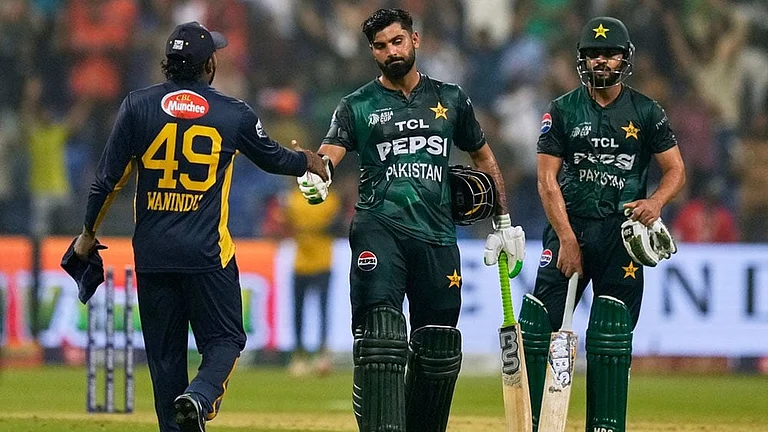India is the flavour of the season. Go down the Oxford Street, Champs Elysees or the Fifth Avenue and dont be surprised to see Indian brocades adorning shirt cuffs or collars, or, embroidered seams and mirror-work making a fashion statement on trousers and jeans. Indian haute couture boasts of an eclectic international clientele - from Cherie Blair and Judi Dench to Maggie Smith and Madonna - even as bindis and mehndi have become essential components of their makeup kits. Isnt it imperative then for Indian designers to aim beyond their friendly neighbourhoods and eye the larger global fraternity.
No wonder then that one of the important aims of the recent Lakme India Fashion Week (lifw) was to provide a platform for the fashion industry to promote Indian pret-a-porter (ready-to-wear) in the international market. When megamodel Jodie Kidd took her giant strides on the Indian ramp, it was all to catch the worlds eye. So was it when internationally renowned Italian hairstylist Aldo Signoretti and make-up artist Gini Bogado tried out new looks on the Indian models. However, a more significant foreign presence almost went unnoticed in the hullabaloo of the first Indian fashion mela. That too when Victor Castelino made one of the most important pronouncements on Indian fashion. On his whistle-stop visit, the senior vice president (Asia and Europe) of Britain-based May International Stores said that he found some of the Indian designers impressive enough to sell internationally. "Ill have no hesitation in buying some of the stuff that I have seen," he said. An appreciative pat enough to strike a buoyant note.
So do we see Indian designers rubbing shoulders with a Gucci or Donna Karan soon? While we may be busy taking our first tentative steps, there are many more miles to go and each step forward also brings us closer to some bitter but real truths. Take the fashion week itself. Foreign buyers, international departmental stores and exporters were there in plenty, but their presence remained small and much too discreet. There were stray remarks about exporters interested in the works of some designers. Castelino is reported to be impressed with the smart fits and finish of Rajesh Pratap Singh who is already being compared to Prada and Chanel. Gitanjali Kashyap was appreciated for her "thematically consistent, mature and no-frills collection". Rohit Bals "stunning men in white" typified fun and flamboyance of fashion. Fasateen, a Dubai-based high fashion retail house, was impressed with the Indian pret of Ritu Kumar and Anuradha Vakil and the "elegant, uncluttered" western pret of Ashish Soni.
But still, these did not translate into any significant business transaction during the week-long mela. Perhaps, because the idea was more to initiate talks and strengthen relationships. But this surely cant be an excuse to hide the fact that some designers spent more time partying with friends than participate in serious seminars - be it for sessions with Castelino or Indian retail houses.
There were many other obvious flaws which caught the discerning foreign eye. The event itself focused on the Autumn/Winter 2000 collection, and there wasnt anyone to address the fact that international stores work 15 months ahead of the calendar - a reason why no deals could have fructified. After all, fashion is essentially all about predicting tomorrows designs, style, fabrics and colour and not showcasing todays trends. No designer, barring a Geetanjali Kashyap or Ashish Soni, put detailed descriptions about their work on paper to help the buyer make an easy and informed choice. Clearly the stress was on showmanship than value addition. Manish Aroras shows were dramatic and full of theatrics, but the dim lights made it difficult to distinguish the fabric or the colour of the attires.
So are Indian designers ready for the kill? "They have made fantastic progress but are not yet ready to take on the world," feels Francis Wacziarg of Francis Wacziarg Private Limited, which operates in France and Spain. Castelino feels that Indian designers need to focus on some elements like "consistency of quality, style, reliability, and competitive pricing" to hit the global fashion scene. But, sadly, many dont have the financial pull or the capacity to deliver an entire pret range of good quality to foreign stores and that too on time.
Another deterrent is their failure to understand the foreign customer. "They are confused about who they are catering to - Indians or the westernised Indians?" asks Wacziarg. "They need to cut the umbilical chord. While maintaining the Indian accent, they must to create attractive garments which are globally acceptable," says Castelino. "They have approached the foreign market with the nri in mind, but you need to be in the mainstream, and not ethnocentric," says Umang Hutheesing, event consultant and an expert on Indian textiles. Such events, he says, should be segmented into Indian and western pret to reach out to the target audience. Muhammad Murad of Fasateen feels Indian designers need to reconsider their price tags. "Why would anyone in Dubai want to buy an Indian pret collection when they have free access to mexx or Next?" he asks.
On the other hand, Indian designers have their own lament. They dont have the dollars to launch a publicity offensive. And then, marketing pret cant be a self-supporting exercise. They say theres need for alliances with corporate houses for marketing and advertising support. Manoviraj Khosla, for instance, has come up with the Kingfisher range. Moreover, western retailers come to India with preconceived notions and look at Indian designers as cheap merchandise churners. "They only look for cheap buys and dont want anything more than $25 a piece. They have a mental block, we dont have a disability," says Rohit Bal.
For optimists, future fashion weeks will prove to be the best launchpad for them to go global. But for that itll need to be spun on commerce, and not on glamour. The front rows will need to be occupied by representatives of the buying houses or of ficci and cii, not by the perfumed socialites. "Without a buyer, it is all just a circus," says a visitor. "But this is not a full stop, its just the first letter," says Hutheesing. The sentence still needs to be written.






















